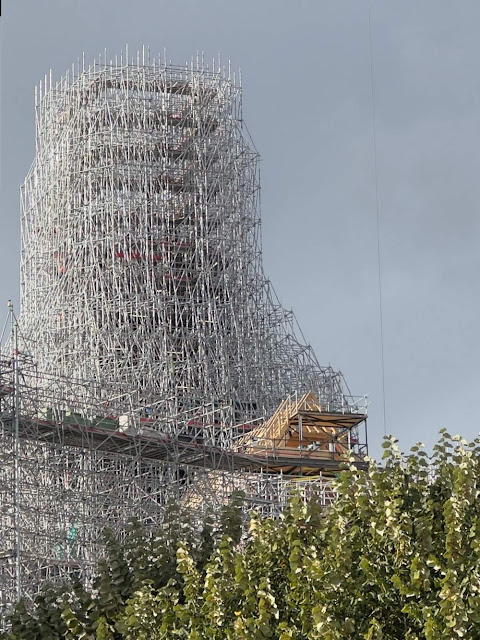DAY 516 | Après l'ordalie
Blaze to Glory
L’échafaudage de la flèche de Notre-Dame et la charpente du chœur en cours de restauration.
La nouvelle flèche de Notre-Dame prend forme. Ces décors en bois sculpté dessinés par Viollet-le-Duc seront bientôt recouverts de plomb martelé. (David Bordes ©️RNDP)
Le square de l’Île-de-France pendant la construction de la nouvelle flèche de Notre-Dame, depuis le quai d’Orléans.
L’achèvement de la pose d'une partie de la souche (voir schéma ci-dessus).
Et pendant que l’échafaudage de la flèche de Notre-Dame continue de s’élever dans le ciel, on démonte les échafaudages à l’intérieur… (Romaric Toussaint ©️RNDP)
Après une superbe restauration, les vitraux de Notre-Dame ont tous retrouvé leur place ! Les derniers à avoir été posés sont ceux représentant le Christ couronnant la Vierge Marie. (©️P. Zachmann/Magnum Photo/RNDP)
Près de 400 pompiers de Paris accompagnés de nombreux renforts sont intervenus au moyen de nombreux bras élévateurs qui ont projeté plus de 24.000 litres d'eau par minute, soit l'équivalent du largage de 4 canadairs par minute.
L'incendie a ravagé la charpente et provoqué l'effondrement de la flèche. Cependant, la structure de la cathédrale et les principales œuvres d’art ont pu être sauvegardées. (Source: Sapeurs-Pompiers de France, 16 avril 2019)
Trial by Fire
On April 15, 2019, the world watched in shock and horror as a devastating fire engulfed the iconic Notre Dame Cathedral in the heart of Paris. The blaze, which began in the cathedral's attic, threatened to reduce this centuries-old masterpiece of Gothic architecture to ruins. It was a tragic moment that sent shockwaves through France and around the globe.
The fire's origins were uncertain, but its consequences were all too real. As flames and billowing smoke filled the Parisian sky, onlookers gathered on the banks of the Seine, their hearts heavy with a sense of helplessness. The spire, an iconic element of Notre Dame, collapsed dramatically, adding to the sense of loss and despair.
The Battle Against the Inferno
Amid the chaos and devastation, Paris firefighters demonstrated extraordinary courage and determination. Over 400 firefighters were dispatched to the scene, and they faced a monumental challenge. The cathedral's intricate structure made it difficult to combat the blaze effectively. Firefighters had to navigate the labyrinthine interior, often in hazardous conditions, as they worked to save the cathedral from total destruction.
As night fell, it seemed that Notre Dame might be lost forever. Yet, these dedicated individuals refused to yield. Hours turned into a grueling night of firefighting, but their relentless efforts paid off. They managed to bring the fire under control and save the main structure of the cathedral.
Restoration: A Journey of Hope and Resilience
The immediate aftermath of the fire was marked by a global outpouring of grief and support. Offers of financial assistance and expertise poured in from around the world. The restoration of Notre Dame Cathedral became a symbol of hope and resilience, demonstrating humanity's determination to preserve its cultural heritage.
The restoration process was not just about rebuilding; it was about preserving the spirit and history of Notre Dame. Teams of architects, historians, and skilled craftsmen worked tirelessly to assess the damage and plan the reconstruction. Cutting-edge technology, such as 3D imaging and laser scans, was employed to document and replicate the intricate details of the original structure.
The Notre Dame restoration project aimed to honor the past while incorporating modern elements to ensure the building's longevity. The rebuilding process was a delicate balance between preservation and innovation, a testament to the enduring power of human spirit.
The 2019 blaze that partially ruined Notre Dame Cathedral in Paris was a devastating tragedy that brought to the forefront the heroism of Paris firefighters who risked their lives to save this historic landmark. The ongoing restoration work is a beacon of hope and a demonstration of the indomitable spirit of culture and heritage. Notre Dame, once again, rises from the ashes, showcasing the resilience and unity of humanity in the face of tragedy.
A symbol of France's history and cultural heritage
The construction of this iconic cathedral began in 1163, during the reign of King Louis VII, and took nearly two centuries to complete, with the final touches added in 1345. Its impressive Gothic architecture, featuring flying buttresses and intricate stained glass windows, made it a masterpiece of its era.
Over the centuries, Notre Dame witnessed many historical events. During the French Revolution, it suffered damage and was repurposed as a Temple of Reason, losing many of its original treasures. In the 19th century, Victor Hugo's novel "The Hunchback of Notre-Dame" brought attention back to the cathedral, leading to a restoration campaign.
Notre Dame de Paris is a quintessential example of Gothic architecture, a style that defined the era in which it was built. Its design is characterized by soaring spires, intricate stone tracery, and flying buttresses, all of which showcase the remarkable craftsmanship of the medieval builders.
The cathedral's imposing façade features three striking portals adorned with detailed sculptures that tell biblical stories, and its stunning rose windows, such as the famous South Rose, are renowned for their intricate stained glass designs.
The ribbed vaults inside create a sense of height and grandeur, while the use of pointed arches and large windows allows for an abundance of natural light.
The cathedral's architectural elements not only reflect the aesthetic preferences of the time but also serve as a testament to the innovative engineering solutions of the era, making Notre Dame de Paris a true masterpiece of Gothic design.
Eugène Viollet-le-Duc, a renowned French architect, was responsible for the significant restoration of the cathedral in the mid-19th century. His work, which began in 1844, aimed to preserve and enhance the decaying structure of Notre Dame.
Viollet-le-Duc's restoration efforts included the construction of the spire, which was not part of the original medieval design but became an iconic addition under his guidance. His meticulous attention to detail ensured that the cathedral's Gothic features were faithfully restored, and he also added his own artistic touches, blending his interpretation of Gothic style with the building's original form.
(MNC, October 28, 2023)
*Click*
Disclaimer: If you are the copyright owner of a photograph, video, artwork, text posted to this nonprofit blog and want it removed/credited, please contact me at mynarrowcorner@gmail.com and the item(s) will be promptly taken down/credited.
























vous allez rire mais le premier cliché m'a fait imaginer un " con* " - référence au film du diner - qui créerait un bâtiment en superposant des épingles à faufiler
ReplyDelete* avec de meilleurs yeux et doigts j'aurais voulu être celui là